Bent over, with the smell of freshly fried tea literally steaming into me I am struck that the wafts emanating upwards seem a combination of sweet corn and spinach. Not that it matters really, but I do spend an inordinate amount of time and brain space considering tea and all of its aspects. Much time has been spent trying to formulate what it is exactly that makes tea such a potent and formidable part of most of my days.
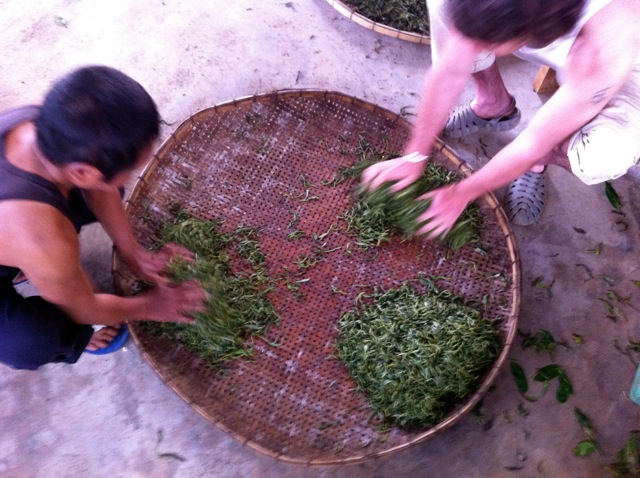
Each stage of the tea process needs the hands and head. Here I involve my hands kneading the tea leaves in ‘Gao’s Tea Headquarters’.
Marco sits across from me kneeling, kneading the pliant leaves in slow methodical movements. I too share in this movement – the three of us are bound by the leaves that lie beneath our hands. Gao stands above us like the colonel that he is. He (and we) have been at it for two hours. It is late afternoon and we’ve literally got our hands wrist deep in the tea preparing it for drinkers that will inevitably descend.
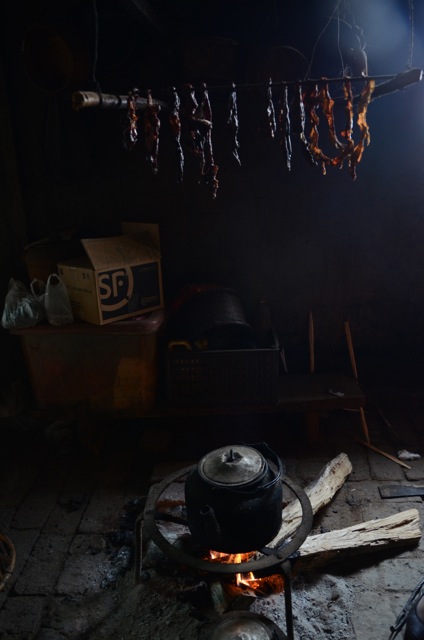
Inside a local kitchen with strips of pork hanging above the fire pit. Regardless of the money that flows in many areas remain simple and traditional
We are participating in tea’s great unchanged production rituals. Below Gao’s home we are in a small open room that backs onto an open valley of orange dirt. Gao sweats, I grunt, and Marco mutters as we are all in our own little worlds of tea. Once in a while Gao looks over his shoulder at us and only once does he say anything. “Don’t push too hard or else you’ll damage the leaves” he tells us. We nod, eager to please as this is no idle warning to us as beneath our fingers and palms, Marco and I have about 5 kg’s of prime spring harvest off of the old tea trees – in other words a fortune. To bruise the leaves will be catamount to committing a great sin, and neither of us have any thoughts of sin in this sanctum of all that is ‘tea-holy’. The final worth of this tea from Lao Banzhang’s primordial tea forests will be almost $5,000 USD. It is already sold. Gao’s teas are often bought a year in advance, so trusted are his abilities to not only source but also to produce teas of magnificent quality.
With this in mind I wonder why Marco and I are allowed to participate. He simply tells me at one stage: “You care too much not to produce a quality tea. Your technique is fine and you are both stressed, which is a good thing. Tea needs attention”. I wonder aloud if this means we will get to actually receive some of this tea as a kind of reward or payment for work done. The answer is one of Gao’s simple but very effective smiles of “NO”. There is, however, a very good chance that Gao will relent. I’ve often been the happy recipient of Gao’s teas as a kind of informal ‘thank-you’ for services rendered.
Freshly picked leaves lie on a rattan matt just behind where I sit. This is the withering stage where the leaves oxidize ever so slightly and become limp in the careful grey tones of the shade. Gao takes these leaves, which are carried in by his daughter and wife, and dumps them into his large wok which is heated carefully by wood.
If too hot the leaves will burn which will ruin the entire batch, not hot enough and the leaves will need ‘too’ much time upon the steel of the wok affecting flavor, too much smoke and the leaves will absorb the wood fire’s every nuance. It is a simple procedure needing an exacting knowledge and precision.
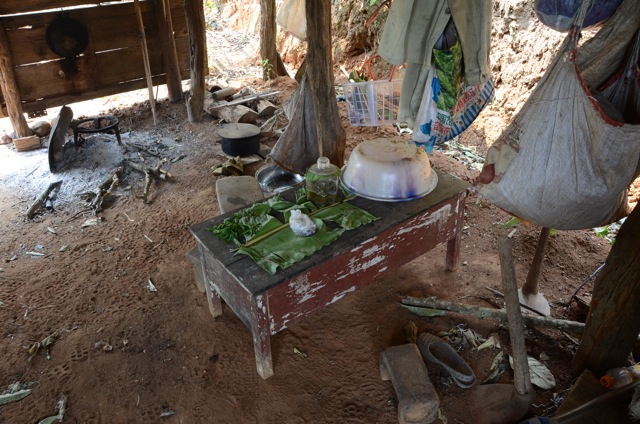
The interior of a tea harvester’s hut. Food, water, fire and a rest area provide a ‘home’ high upon the tea mountains for the busy villagers
Gao then proceeds in his ‘work’. His arms and hands (and two bamboo prongs) do not stop for more than a second or two, gently churning the leaves. It is as though Gao’s powerful arms have taken the place of a tumbler dryer. The work is both physical and meticulous at the same time, but Gao is thoroughly in his element. His powerful arms have been doing this for decades. When he is done he dumps the resultant fried leaves – which have now been fried down to a quarter of the original volume – onto trays to rest for a few minutes. At this point Marco and I come happily into the process. First, we gently sort and separate the damp (and at times brutally hot) leaves so that the leaves aerate slightly. Then a kneading action (“gently”, we are reminded by the ever-vigilant Gao) rolls the leaves and makes them pliant, which is much like kneading dough. Yet another sorting and aerating activity, which separates the leaves, follow this action. This is simply lifting up handfuls of the green and shaking the hands to let the leaves fall through the fingers. Our esteemed leader and my Yunnan uncle watches and sees everything. No batch of tea is beyond his attention and sometimes he will simply nod or pick up a few strands of leaves and twitch his moustache.
Once the leaves are laid out they are then taken upstairs on the circular rattan trays that I love so much and placed under the sun. The rattan mats are stained from years of providing a resting place for tea leaves and in there rugged shapes and colours, they represent some of the beautiful tea process that is rarely seen. This entire procedure – from harvesting to drying place – happens in two major sessions during the day: once in the late morning and once late afternoon.
Finishing up signifies dinner, but Gao ushers us up to the roof-top. Dinner can wait, as there is a ‘tea issue’ that needs clearing up. Something has disturbed his eminence; something he had seen earlier and made his soft eyes harden temporarily. I had asked him about it but he had simply commented, “It isn’t a problem on our end”.
Reaching the roof-top which is covered in trays of tea leaves, Gao unhesitatingly makes his way to the ‘offending’ leaves which lay innocently awaiting judgment. We move the mats onto racks to dry for the night protected from the ‘enemy’ of every tea mat: rain. Gao picks up a few leaves and gives me some and his question is clear without him actually needing to verbalize it: “What is wrong with this tea”?
It only occurs to me after a minute or so that there are not the standard ‘two leaves and a bud’ present in this collection, but rather ‘three leaves and one bud’. Gao looks at the offending examples of his precious tea without expression. It is the sad and weary look of someone looking at misguided perfection. Perfect leaves, imperfectly clipped. Not a total disaster, but certainly a small one.
“We cannot sell this tea”, he says looking more closely at the tea as though there might be other unsavory elements to the tea besides the one extra leaf.
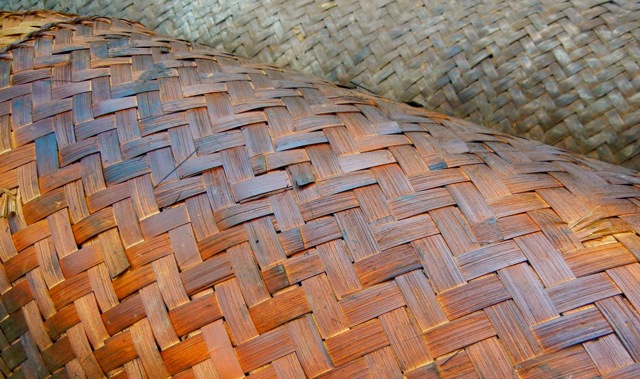
Tea stained mats are in action for much of the year and they themselves have their own tales to tell about tea
In Yunnan and indeed much of China, the standard for a tea is either the ‘two leaves, one bud’ or ‘one bud and one leaf’. In the case of white tea it is often a single bud or leaf. For Gao’s creations, it has always been the ‘two leaves, one bud’ but what we now stare at in a kind of blank daze is ‘three leaves and one bud’ configuration. Great leaves gone wrong! I would be happy accepting these four-leaf-oddities if he cannot manage to sell them or find them a home. I casually mention this to Gao, though I don’t even get the benefit of a response, though it cannot hurt trying.
Gao mentions that this year he has had to hire a couple from Burma, who have made this mistake before. He goes on to tell us that he will inform them again of his standards. I feel the dual prongs of a heavy heart for the couple, and a sense of injustice at they having messed up a batch of tea.
Later during a meal sitting with Gao’s family – including the husband and wife couple from Burma – Gao softly explains that the clippings need to be in the ‘two leaves, one bud’ format. The couple who are also of the Hani minority softly nod while eating the potent ‘sour-spice’ flavored plates before us. Gao smiles one of those understated smiles of his, happy to be rid of the dirty business, and decrees that a “glass” of local firewater will be consumed. This “glass” he speaks of is rarely – if ever – a single glass, and Marco glances over at me with what we now refer to as the “here it comes” look. What is magic though, is that after a few snorts of the whisky our evening (like all here) will end with a few cups of tea around the tea table and talk of tea. It is the ‘digestif’ of every night in these parts.
There is the recurring fantasy that somehow the tea with its extra leaf will somehow at some point end up in one of my bags.

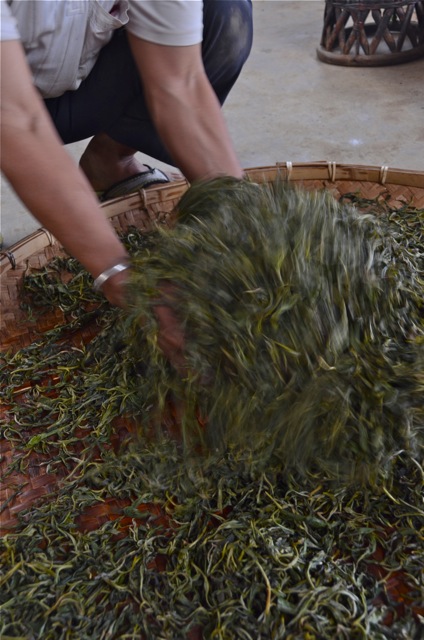

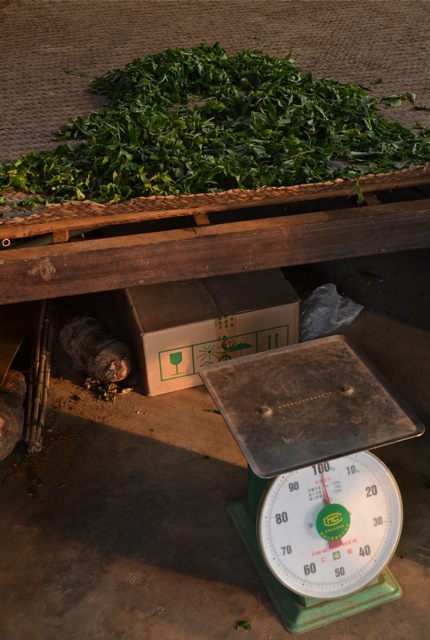
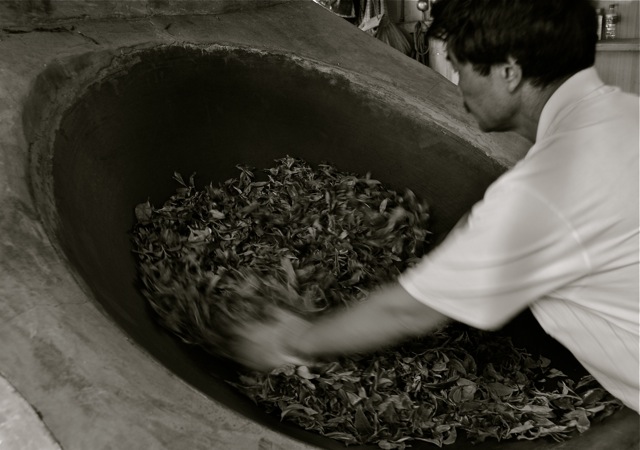
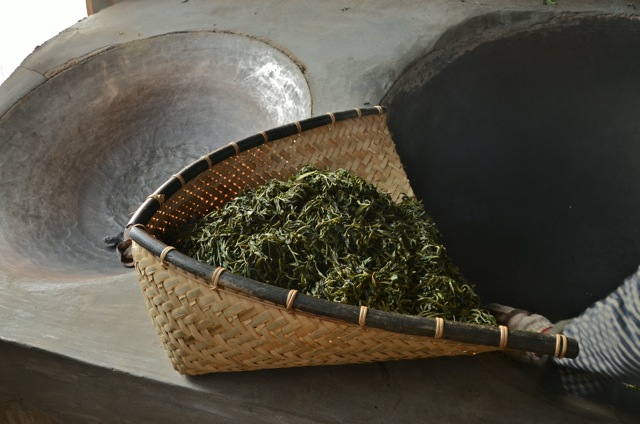


Do you think that some of the rejected tea could find it’s way to my bag here in the UK!
I’d chip in for the postage!!!!
I think a small package of the better (3 leaf) green can find its way to you – I’ll be in touch.
J